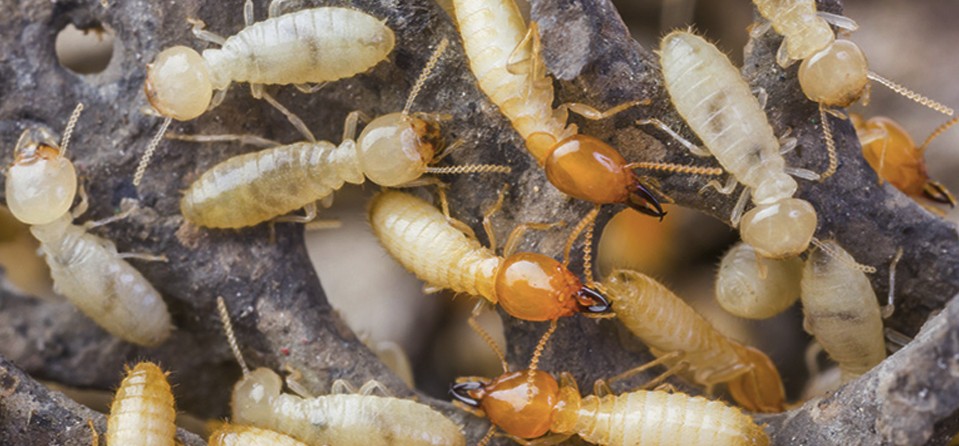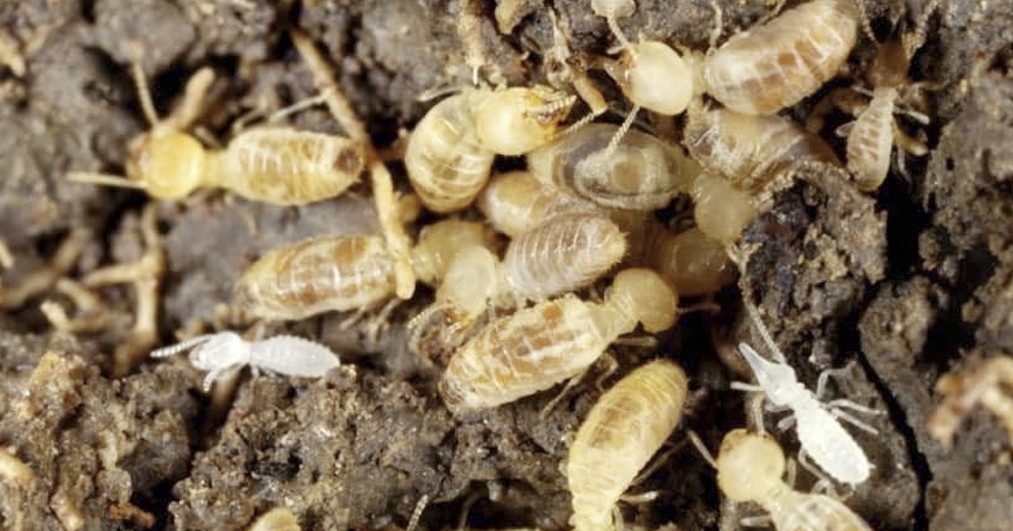Subterranean Termites
What are Subterranean Termites?
Subterranean termites, found throughout the United States, are the most widespread type of termites that invade homes in packs. Usually found in warmer climates, these insects need humidity to continue to exist. These insects have a lot to do with the soil, where they build their underground nest or a chain of interrelated nests. That’s how they got their name, “subterranean termites.”

Soil acts as a good source of moisture that keeps the subterranean termites from drying effects of air. Also, it safeguards against other predators such as birds, lizards, ants, and many more. These insects dig out tapered tunnels through the soil. Hence, they are successfully able to create a network that helps subterranean termites cover a long distance to get to their food source. Moreover, they carry the soil above ground for making mud tubes.
Being social creatures, these termites reside in colonies or nests in the soil. Their territories are categorized into castes that depend on diverse tasks these bugs are required to carry out – workers, soldiers, and reproductive packs. Well, the features of this (subterranean) termites are entirely reliant on the role of this bug in the colony.
There is no question that insects excavate in the soil so that they can acquire much-needed moisture, but are you aware of the fact that they can dig a hole in the wood that’s often damp? When they come in contact with any wood, they can attack it without any hassle. And, if the wood does not contact the soil, termites can easily construct mud tunnels for the sake of reaching wood that’s several feet under the ground. They can also penetrate one’s house through utilities.
With the arrival of homes having a centrally heated system, it has become a lot easier for subterranean termites to gain entry into almost every house for quick invasion. So, the fact cannot be held for denial that they have become a significant threat not only in every region but every American state as well. On average, as many as 14 subterranean termites’ colonies could be found per acre.
Coming from the Isoptera insect order, there are three diverse forms of these bugs. Having been in existence for millions of years, subterranean termites have got their name after existing in the soil in colonies. They pass through from their colonies in the soil to obtain their source of food, which includes:
- Trees
- Homes
- Scrap Wood
Identification

Termites are mostly segregated into three major termite groups, including:
- Subterranean
- Drywood
- Dampwood
Trying to categorize a specific colony of termites into a group, it’s essential for you to look at the soldiers as well as the alates and not to mention, the winged, reproducing caste. This is because worker termites mostly look the same from corner to corner. And, the appearance of the damaged wood these pests feed on plays a very significant role.
Here are the identification factors for subterranean termites:
- Alates (swarmers) – With a dark brown or black color, they are almost ¼ to a ½ inch long having two pairs of wings.
- Workers – They don’t have wings, but are about a ¼ inch or less in length, aside from being cream colored.
- Soldiers – The saviors of the termite colony (with a brownish head) don’t have wings, but they do have large jaws. They are creamy-white.
The appearance of Damaged Wood – Since these insects build their nests underneath the ground, damaged wood has a deposit of soil or mud within the wood tunnels they are consuming. These subterranean termites only feed on the softwood.
Nest Location – In general, the nest can be found under the ground. Also, it is quite possible to find the nests above the ground, but this happens only when enough dampness is available for supporting the nest, and the colony is not only old but correctly set up as well.
Even though soldier termites have the same length as that of workers, they have bigger heads with sharp mandibles. Not even primary, but supplementary reproductives measure around an inch in diameter. In the same way, these insects (subterranean termites) have a contrasting color according to their caste. Both soldiers and workers are of cream color, and they are pale too sometimes. However, the heads of soldiers are brown. While a primary reproductive can be black or brown, a sedentary reproductive, on the other hand, has a thick shade.
Habitat
Subterranean termites live in underground colonies. They build tunnels from these colonies to search for food.
The nesting mode of these insects is within the soil. In fact, they have various modes of nesting, including:
- Mound Nesting
- Wood Nesting
- Arboreal Nesting
Of all the modes available for subterranean termites, soil nesting is the most common nesting mode for a myriad of species. This nesting provides a multitude of great benefits to termites, and there are some species that can be extremely flexible when it comes to living together with humans in the environments that are modified by humans, for example, urban and semi-urban areas.
These insects build diverse types of nest. Some are known to exist entirely underneath the ground, and they don’t have a central nest. Other termites prefer building a central nest in the soil, living or even dead trees. Several reasonably crucial subterranean termites make this type of nest. However, some species place a great emphasis on attaching their nest to a tree, but they do keep hold of a soil connection employing galleries, which run down the trunk’s surface.
Eating Habits
Subterranean termites build individual tunnels, which are often referred to as “mud tubes” so that they can make it to food sources. These tunnels keep these insects protected against open air. They use their jaws shaped like scissors for munching on wood around the clock (24/7).
Also, these termites feed on products that consist of cellulose. Subterranean termites flock in the spring when many groups of reproductive females set off on a journey for starting new colonies. They feed on wood, plastics, wallpaper, and plant made fabric.
Life Cycle
The growth of a subterranean termite is known as incomplete metamorphosis. Also, it is technically called hemimetabolous life cycles. The life cycle of this insect can cause three various types of termites. These types include Reproductive, Workers, and Soldiers.
The life cycle of these termites comprises the following:
- Egg
- Young Termite Larvae (or Termite Nymph)
- Older Nymph
- Worker
- Soldier
- Pseudergate
- Drone
- Queen
Once the egg of a termite among several thousands of others hatches, it’s known as termite larva (e).
The queen lays numerous eggs daily. However, there are queen termites of some species that may give off 20,000 to 30,000 eggs each day. The life span of these pests starts when it hatches as an immature termite or nymph. Termites then develop, and they fall in the social structure sooner or later. The queen of the termite colony can not only control but restrain the growth of other queens with pheromones that are maintained by her within the colony all the time.
Subterranean Termites Vs. Drywood Termites
There is no denying the fact that due to the damaging dietary requirements of subterranean termites, they are contemplated to be one of the most expensive pests, especially for homeowners.
Well, there are two of the most common termite types that are extensively known to make their way to our homes: subterranean termites and drywood termites. Let’s find out the difference between the two:
Subterranean Termites
Subterranean termites, being the most common species that we know of, are known to cause extensive damage to buildings in every nook and corner of the world. These types, as compared to drywood termites, survive on a diet of softwood.
What Do Subterranean termites Look Like?
Well, there is not much difference between the two types: subterranean and drywood. The soldier and alate castes are where these types of termites tend to differ. Soldier termites have a larger head in yellowish-brown color. The flying termites (alates) are, on the other hand, usually are dark brown/ black color.
Subterranean termites, as opposed to drywood termites, prefer living in the ground. This is because these species need moisture for survival.
Drywood Termites
What Do Drywood Termites Look Like?
Drywood termites almost bear a resemblance to subterranean termites. They can not only be found in white but brown in color. At times, they can be lucid as well. If there is one thing that differentiates the two species, it is the size. This is because drywood termites are more extensive than subterranean ones.
Drywood termites have a thing about building their nests within the wooden structures. They like to reside in these structures, hence the name.
Subterranean Termite Control

Well, the best method to control subterranean termites is to prevent the accumulation of water near the foundation of your home. Make sure the water is diverted away with splash blocks, gutters and downspouts (ensure that they are properly functioning.
Moreover, the humidity is reduced in crawl spaces with the right ventilation system. Avoid burying waste lumber or wood scraps in the yard. It is essential that you remove the wood contact with the soil. Make sure that the one-inch gap is maintained between the soil and wood portions.
Some Useful Tips to Control Subterranean Termites
The attacks of subterranean termites are smart, which often go undetected for several years. And, it’s a known fact that they cause severe damage in the years to come. Waiting for these termites to show up is never a good sign. Instead, call in a professional pest control service provider because they know where to look and what all should be done to keep these unwelcome guests out of your house. These exterminators will give you the much-needed protection and peace of mind.
For the prevention of termites, you should:
- Get rid of all the leaks as well as moisture from your home.
- Store all firewood away.
- Ensure that all drainage systems are properly cleaned.
Sanitation plays a very crucial role when it comes to getting rid of subterranean termites. Make sure you keep vines, trellises and trees pruned, so that they don’t come in contact with the structure. These insects feed on the bait and take it back to their colony. Termite baiting is a good thing, as it has a significant effect on the whole termite colony. As a result, their population is overpowered. It can lead to the death of the colony sooner or later.
Pictures
Here are some pictures of subterranean termites:



Facts
Some of the most interesting facts associated with subterranean termites include:
- Subterranean termites can work 24/7 and eat throughout the day.
- Subterranean termites don’t have diverse body segments.
- Subterranean termites are somewhat larger, as compared to other ants.
- These insects are fond of wood, shelter, and water.
- One colony can have millions of subterranean termites.
- The worker subterranean termites not only feed but also care for all the colony members.
